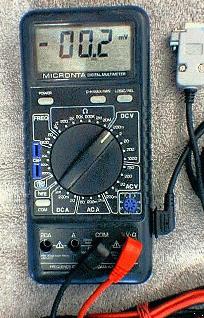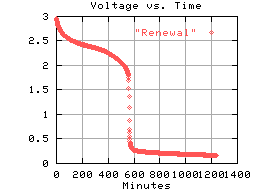Introduction
Protocol
C Program
An Application
Introduction
 The "Micronta LCD Digital Multimeter" is a fairly nice 3 1/2 digit
multimeter (DMM) with an RS-232 output to report the readings.
The older unit (pictured) has part number 22-182 and the newer
unit has part number 22-168. The catalog list price is $129.99
but it goes on sale for $100 or $110 once in a while.
The older DMM features :
The "Micronta LCD Digital Multimeter" is a fairly nice 3 1/2 digit
multimeter (DMM) with an RS-232 output to report the readings.
The older unit (pictured) has part number 22-182 and the newer
unit has part number 22-168. The catalog list price is $129.99
but it goes on sale for $100 or $110 once in a while.
The older DMM features :
- DC Voltage: 0.1 mV to 1000 V
- AC Voltage: 0.1 mV to 750 V
- DC Current: 0.001 mA to 20 A
- AC Current: 0.001 mA to 20 A
- Resistance: 0.1 ohm to 20 Mohm
- Frequency: 10 Hz to 200 kHz
- Capacitance: 1 pF to 20 uF
- Transistor Gain: 0-1000 hFE
- Continuity Checker
 The DMM has a 5 pin in-line connector for the RS-232 output.
A supplied cable has the mating 5 pin plug on one end and a
female 9 pin D connector on the other end. The cable is
configured as a DCE so it can plug directly into a PC serial port.
The DMM has a 5 pin in-line connector for the RS-232 output.
A supplied cable has the mating 5 pin plug on one end and a
female 9 pin D connector on the other end. The cable is
configured as a DCE so it can plug directly into a PC serial port.
Other DMMs with RS-232 are available.
Jameco catalog #942 lists four of them; one by Protek and
three by Metex. The Techni-Tool catalog #58 lists an Extech
DMM which has a serial interface.
Protocol
It looks like the DMM uses RTS and DTR to power the serial
port. DTR needs to be set to +12 volts and RTS must be set
to -12 volts. The port should be configured for 7 data bits,
no parity, and two stop bits (7,N,2) at 1200 baud.
Take a reading by sending a "D" character to the DMM and
then read characters from the serial port until a carriage
return is found. The format of the returned data is a 13
character line terminated by a carriage return.
Byte) 12345678901234
Ex.1) DC-1.9999 V CR
Ex.2) 1.9999MohmCR
C Program
The following C program takes a reading every 60 seconds.
/*
* Name: dvm
*
* Description:
* A simple program to read a value from the Radio Shack
* digital multimeter every 60 seconds.
*
* Example:
* dvm /dev/tty02 > readings
*
*/
#include <stdio.h>
#include <termio.h>
#include <sys/fcntl.h>
#include <unistd.h>
#include <sys/ioctl.h>
int main (int argc, char *argv[])
{
int m; /* modem control lines */
int fd_dev; /* FD for the open serial port */
char c; /* char received from the DMM */
struct termios tbuf; /* serial line settings */
if (argc != 2) {
printf("Usage: %s [tty port]\n", argv[0]);
exit(1);
}
if (( fd_dev = open(argv[1], O_RDWR, 0)) < 0 ) {
printf("Unable to open tty port specified\n");
exit(1);
}
/* set up the line parameters : 7,2,N */
tbuf.c_cflag = CS7|CREAD|CSTOPB|B1200|CLOCAL;
tbuf.c_iflag = IGNBRK;
tbuf.c_oflag = 0;
tbuf.c_lflag = 0;
tbuf.c_cc[VMIN] = 1; /* character-by-character input */
tbuf.c_cc[VTIME]= 0; /* no delay waiting for characters */
if (tcsetattr(fd_dev, TCSANOW, &tbuf) < 0) {
printf("%s: Unable to set device '%s' parameters\n",argv[0], argv[1]);
exit(1);
}
/* Set DTR (to +12 volts) */
m = TIOCM_DTR;
if (ioctl(fd_dev, TIOCMSET, &m) < 0) {
printf("%s: Unable to set '%s' modem status\n",argv[0], argv[1]);
exit(1);
}
while (1) {
write(fd_dev,"D", 1);
do {
read(fd_dev, &c, 1);
write(1, &c, 1);
} while (c != '\r');
write(1, "\n", 1);
sleep(60);
}
/* This program is rude in that it does not restore the */
/* serial line parameters on exit. */
exit(0);
}
An Application
 We use the Radio Shack DMM and the above program to measure the
discharge curves for several AAA batteries. We tested two
batteries in series with a load of 33 ohms. The batteries tested
include Energizer, Duracell, Radio Shack, and Renewal.
We use various Linux tools to format the data and we use gnuplot
to build the actual plot images.
We use the Radio Shack DMM and the above program to measure the
discharge curves for several AAA batteries. We tested two
batteries in series with a load of 33 ohms. The batteries tested
include Energizer, Duracell, Radio Shack, and Renewal.
We use various Linux tools to format the data and we use gnuplot
to build the actual plot images.
Click Energizer
or Duracell ? for the full report.
 The "Micronta LCD Digital Multimeter" is a fairly nice 3 1/2 digit
multimeter (DMM) with an RS-232 output to report the readings.
The older unit (pictured) has part number 22-182 and the newer
unit has part number 22-168. The catalog list price is $129.99
but it goes on sale for $100 or $110 once in a while.
The older DMM features :
The "Micronta LCD Digital Multimeter" is a fairly nice 3 1/2 digit
multimeter (DMM) with an RS-232 output to report the readings.
The older unit (pictured) has part number 22-182 and the newer
unit has part number 22-168. The catalog list price is $129.99
but it goes on sale for $100 or $110 once in a while.
The older DMM features :
 The DMM has a 5 pin in-line connector for the RS-232 output.
A supplied cable has the mating 5 pin plug on one end and a
female 9 pin D connector on the other end. The cable is
configured as a DCE so it can plug directly into a PC serial port.
The DMM has a 5 pin in-line connector for the RS-232 output.
A supplied cable has the mating 5 pin plug on one end and a
female 9 pin D connector on the other end. The cable is
configured as a DCE so it can plug directly into a PC serial port.
 We use the Radio Shack DMM and the above program to measure the
discharge curves for several AAA batteries. We tested two
batteries in series with a load of 33 ohms. The batteries tested
include Energizer, Duracell, Radio Shack, and Renewal.
We use various Linux tools to format the data and we use gnuplot
to build the actual plot images.
We use the Radio Shack DMM and the above program to measure the
discharge curves for several AAA batteries. We tested two
batteries in series with a load of 33 ohms. The batteries tested
include Energizer, Duracell, Radio Shack, and Renewal.
We use various Linux tools to format the data and we use gnuplot
to build the actual plot images.